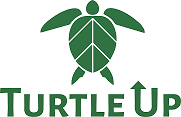Educational Information
Make a Donation
Contact Us
Our Mission
Our mission is to sustainably preserve and conserve Ghana’s sea turtles by utilizing a community-based approach.
Our Vision
Our vision is a world where marine wildlife and people in coastal communities are thriving together.
Our Sponsors
We could not do this without our sponsors. Please visit our sponsors’ page, and better yet, become a sponsor as well!
Our Team
Meet our Board of Directors.
The earliest fossil records show that sea turtles have roamed our planet for 150 million years. While once abundant, all seven species found today are listed as endangered and it’s years of human exploitation that has put them in this perilous position.
As hatchlings, they emerge from their sandy nests, usually under cover of darkness, making their way straight to the sea. This is the only time males will ever be on dry land, the females will return to the same beach from where they hatched (their natal beach) in anything from 10 to 30 years time to lay their own eggs.
Powerful and graceful swimmers, sea turtles migrate many thousands of kilometers during the course of their lives. They migrate great distances to find suitable feeding grounds and then travel back to mate around the shores of their original birthplace. That is, of course, if they are not caught through fisheries, poisoned, or starved to death because of pollution and plastic bag ingestion.
Because of the startlingly high level of sea turtle mortality it is imperative that we protect them at all stages of their life cycle if there are to be any left for future generations to enjoy.
Below is a brief species identification guide along with some of the threats they face and what you can do to help them. Please see our campaigns page for ways in which we are currently helping sea turtles.
Please feel free to download and distribute this PDF to anyone you think may be interested in the conservation of these endangered ancient mariners.
Flatback

SCIENTIFIC NAME: Natator depressus
The flatback sea turtle is named after its flat carapace, or shell, which is unlike the more curved shell of other sea turtle species. The carapace is pale grayish-green in color with the outer margins distinctly upturned. An adult flatback weighs approximately 200 pounds (90 kg) and is roughly 3 feet (0.9 m) in length. They have the smallest distribution of all the species and breed and nest only in Australia.
DISTRIBUTION
The flatback has the smallest geographic range of the seven sea turtle species. Their distribution is restricted to tropical regions of the continental shelf and coastal waters of Northern Australia, the Indonesian archipelago, and the Papua New Guinea coast. They do not have an oceanic phase or undertake long, open ocean migrations like other sea turtles, and are usually found in waters less than 200 feet in depth, in soft-bottomed habitats where they prey on jellyfish, sea cucumbers and soft corals.
Breeding and nesting occur in Australia only with the largest concentration of females nesting on Crab Island in the NE Gulf of Carpentaria in Queensland. Primary nesting beaches are distributed from East to West across Queensland, the Northern Territory, and Western Australia.
MAJOR THREATS
Threats to this species include direct harvest for meat and eggs, entanglement in fishing gear, destruction of nesting beaches from coastal development, pollution, and destruction of feeding habitat (coral reefs and shallow nearshore areas). Dingos and foxes once posed a significant threat to their nests but thanks to predator control programs, this threat has been greatly reduced. Nests and hatchlings however are preyed upon by the Sand Monitor lizard, birds-including Night Herons and Pelicans, and feral pigs. In some areas, feral pigs consume almost all of their nests.
STATUS: IUCN – listed as Data Deficient, Population Trend: Unspecified / Australian Government – listed as Vulnerable
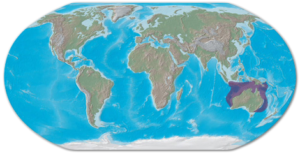
RESOURCES:
Kemps Riley
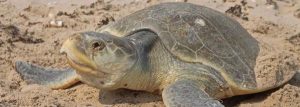
SCIENTIFIC NAME: Lepidochelys kempii
These are the smallest of the seven sea turtle species, weighing between 75-100 pounds (35 – 45 kg) and measuring approximately 2 feet (0.6 m) in length. Until recently, the endangered Kemp’s ridley turtle was on the brink of extinction in the 1960’s. Thanks to strict laws which protected their nesting beaches in Mexico and reduced accidental capture in fishing gear, the species has begun a slow, but steady comeback from a previous low of only 200 nesting individuals in the 1980’s, to an estimated 7,000 – 9,000 individuals today. They are closely related to olive ridley turtles.
DISTRIBUTION
In the US, these turtles are found in the Gulf of Mexico and along the Atlantic coast as far north as Nova Scotia. The primary nesting grounds in Mexico are at Rancho Nuevo, in the state of Tamaulipas, and in Texas along the Padre Island National Seashore. A small number have also nested further north along the Texas coast. However, 95% of all nesting occurs in Mexico in the state of Tamaulipas.
MAJOR THREATS
Their population today is a fraction of the population recorded in the 1940’s. The demise of the population is attributed to human interactions, including the hunting for their meat and eggs. Entanglement in fishing gear also poses an enormous threat for this species. Bottom trawling, longline, and gill net fisheries are all responsible for a large number of deaths every year.
STATUS: IUCN – listed as Critically Endangered, Population Trend: Unknown / ESA – listed as Endangered
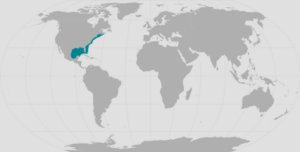
Resources:
- The Story Of The Kemp’s Ridley – Padre Island National Seashore
- Kemp’s Ridley Profile – Padre Island National Seashore
- State of the World’s Turtles: Kemp’s & Olive Ridley Report
- The Conservation Status of the Kemp’s Ridley Worldwide: State of the World’s Turtles (2018)
- Kemp’s Ridley Turtle – NOAA Fisheries
Olive Riley

SCIENTIFIC NAME: Lepidochelys olivacea
The second smallest after the Kemp’s ridley, the olive ridley turtle weighs between 75-100 pounds (34 – 45 kg) and reaches 2-2 ½ feet (roughly 0.6 m) in length. They are named for their pale green carapace, or shell and are the most abundant of sea turtle species. Like the Kemp’s ridley, they nest ‘in mass’ referred to as arribadas. During arribadas, thousands of females may nest over the course of a few days to a few weeks. Adults reach sexual maturity around the age of 15 years.
DISTRIBUTION
Olive ridleys occur globally and are found mainly in tropical regions of the Pacific, Indian, and Southern Atlantic Oceans. They are primarily pelagic, spending much of their life in the open ocean, but may also inhabit continental shelf areas and venture into bays and estuaries. Arribadas occur in Mexico, Nicaragua, Costa Rica, Panama, Australia, parts of Africa, and a few beaches along the coast of India. The largest ones occur in Costa Rica, Mexico, and India. Other solitary nesting areas include Guatemala, Brazil, Myanmar, Malaysia, and Pakistan. Worldwide, they nest in approximately 40 countries.
MAJOR THREATS
Threats to olive ridleys include the direct harvest of turtles and eggs for human consumption, entanglement of turtles in commercial fishing gear, and coastal development.
STATUS: IUCN – listed as Vulnerable, Population Trend: Decreasing / ESA – Pacific Coast of Mexico breeding population listed as Endangered, all other populations as Threatened
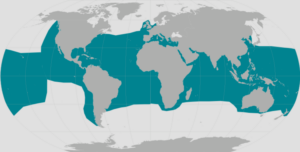
Resources:
Loggerhead
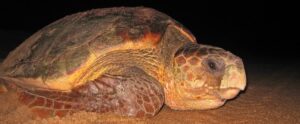
SCIENTIFIC NAME: Caretta caretta
One of the most abundant of the species found in the US, loggerheads are named for their large head and strong crushing jaw which enables them to eat hard-shelled prey such as crabs, conchs, and whelks. One of the larger species of sea turtles, the loggerhead turtle ranges from 200-400 pounds (90 – 180 kg) and up to 4 feet in length (1.2 meters). They occur throughout temperate and tropical regions of the Pacific, Indian, and Atlantic Oceans.
DISTRIBUTION
Loggerheads are found in every ocean around the world. Only leatherbacks have a wider distribution. The largest concentration of nesting occurs on Masirah Island off the coast of Oman in the Middle East. In the Pacific, their main nesting grounds include Japan and Australia. In the Atlantic, the main concentration occurs in Florida. They are the most common species in the Mediterranean, nesting on beaches in Greece, Turkey, and Israel.
MAJOR THREATS
Their biggest threat is entanglement in fishing gear (also known as “bycatch”) in commercial fishing gear, including trawls, longlines, gillnets, and traps and pots. In the US trawl fishery, devices called TED’s, or Turtle Excluder Devices are required by law. These devices allow sea turtles to escape out of the nets, however in other parts of the world these devices are not regulated and they continue to be caught.
STATUS: IUCN – listed as Vulnerable, Population Trend: Decreasing / ESA – nine population segments all listed as Threatened or Endangered
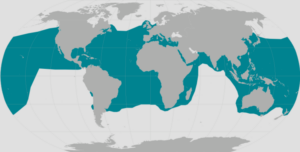
Recources:
- State of the World’s Turtles Loggerhead Report
- Atlantic Loggerheads: Why Isn’t the Best Understood Sea Turtle Recovering? State of the World’s Turtles (2018)
- The Pacific Loggerhead, So Excellent a Connector: State of the World’s Turtles (2018)
- Loggerhead Turtle – NOAA Fisheries
Hawksbill
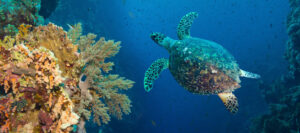
SCIENTIFIC NAME: Eretmochelys imbricata
Considered by many to be the most beautiful of sea turtles for their colorful shells, the hawksbill is found in tropical waters around the world. They spend their time in coral reefs, rocky areas, lagoons, mangroves, oceanic islands, and shallow coastal areas. Named for its narrow head and sharp, bird-like beak, hawksbills can reach into cracks and crevices of coral reefs looking for food. Their diet is very specialized, feeding almost exclusively on sponges. One of the smaller turtles, adults weigh between 100-200 pounds (45 – 90 kg) and reach 2-3 feet (roughly 0.5 to 1 meter) in length.
DISTRIBUTION
This species inhabits tropical and some sub-tropical regions in the Atlantic, Pacific, and Indian Oceans. The largest populations occur in the Caribbean Sea, the Seychelles, Indonesia, Mexico, and Australia. Hawksbills are not found in the Mediterranean and few are found in US waters; only a handful nest in Florida each year.
MAJOR THREATS
Their population has declined more than 80% in the last century, primarily due to the trade in their beautiful carapace (shell), also referred to as “tortoiseshell.” Its carapace, brightly colored with intricate designs, is traded internationally for ornamental purposes. The shell is used for items such as jewelry, combs and brushes, and inlay in furniture and other decorative pieces. Hawksbills were hunted almost to extinction prior to the ban on the tortoiseshell trade; Japan imported an estimated 2 million turtles between 1950 and 1992. Despite the fact that the international trade of their shells is now illegal, there is still a thriving black market.
Other threats include destruction of nesting and feeding habitat, pollution, boat strikes, coastal development, entanglement in fishing gear, consumption of their meat and eggs, and destructive fishing practices like dynamite fishing.
STATUS: IUCN – listed as Critically Endangered, Population Trend: Decreasing / ESA – listed as Endangered
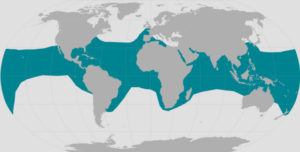
Resources:
Green Turtle
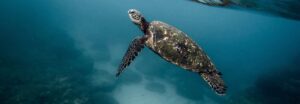
SCIENTIFIC NAME: Chelonia mydas
The green turtle is the second largest after the leatherback. They can weigh up to 500 lbs (225 kg) and reach four feet (1.2 m) in length. The adult is an herbivore, dining on sea grasses, seaweeds, algae and other forms of marine plant life. Their beak is sharp and finely serrated, perfectly adapted for grazing in seagrass beds and scraping algae off of hard surfaces.
DISTRIBUTION
This species can be found in the sub-tropics and tropics worldwide, with major nesting beaches in Tortuguero (Costa Rica), Oman, Florida, and Raine Island (Australia) where thousands of turtles nest each night during peak nesting season. They are also found nesting on French Frigate Shoals in the Northwestern Hawaiian Islands, Guam, American Samoa, Suriname, Georgia, South Carolina, North Carolina, Puerto Rico, and the US Virgin Islands.
MAJOR THREATS
Population declines are mainly due to harvest of their eggs and meat for human consumption. Fibropapilloma (also known as FP) is a disease associated with lesions and rapid tumor growth on the eyes, mouth, and soft-skin areas, as well as internal organs. FP, believed to be connected to ocean pollution, has greatly affected their populations, especially in Florida and Hawaii, but also the Caribbean and Australia. Other threats include plastic ingestion, boat strikes, coastal development, feeding habitat degradation, and entanglement in fishing gear.
STATUS: IUCN – listed as Endangered, Population Trend: Decreasing / ESA – eleven population segments all listed as Threatened or Endangered

Recources:
- State of the World’s Turtles Green Turtle Report
- Green turtle fact sheet: Ocean Conservancy
- Green Turtle – NOAA Fisheries
Leatherback

SCIENTIFIC NAME: Dermochelys coriacea
The largest of all sea turtles, and one of the largest reptiles on earth, the leatherback turtle ranges in size from 4-8 feet in length (1.2 – 2.4 meters) and weighs between 500-2,000 pounds (225 – 900 kg). The average adult measures in between 5-6 feet (1.5 – 1.8 m) and weighs 600-800 pounds (270 – 360 kg). The oldest of all sea turtle species, it has been around for more than 150 million years! They survived the extinction of the dinosaurs and thrived until the last several decades when human interactions have taken a major toll.
DISTRIBUTION
Leatherbacks have the widest distribution of all sea turtle species. They are found throughout the Pacific, Atlantic, and Indian Oceans. In the Pacific, their range extends as far north as Alaska and south beyond the southernmost tip of New Zealand. In the Atlantic, they can be found as far north as Norway and the Arctic Circle and south to the tip of Africa. They are mainly pelagic (open ocean) wanderers but migrate to tropical and subtropical coastal regions to mate and nest.
MAJOR THREATS
The Pacific population has declined by over 90% in the last two decades due primarily to entanglement in commercial fishing gear, particularly longlines and gill nets. Their eggs are also consumed in many parts of the world. These ancient creatures are also vulnerable to ingestion of floating marine debris like discarded plastics. Plastic bags and balloons resemble their favorite prey, jellyfish, and when ingested may block their digestive tract, preventing them from eating.
STATUS: IUCN – listed as Vulnerable, Population Trend: Decreasing – with subpopulations that are listed as Endangered and Critically Endangered / ESA – listed as Endangered
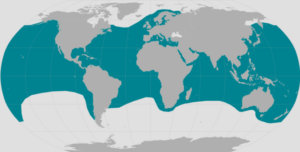
Resources:
Educational Materials
|
Learning Activities |
Types Of Turtles and Resources
|
We believe that one of the best ways towards the conservation of our marine environment for future generations is through the education of present generations. Below you will find a range of downloadable PDFs of primary level educational resources that we hope you and your students will find both fun and useful in your home or classroom.
We will be adding more resources and games as we produce them so please check back for updates. If you have any suggestions we’d love to hear them.
Environmental Habits
Make recycling part of your lifestyle. Did you know that garbage from inland landfills can reach the ocean? Does your school or work place have a recycling program? If not, consider starting one!
Be Aware of Chemicals
Oxybenzone is a common chemical found in sunscreen, and it is harmful to coral reefs. Use sunscreens that are oxybenzone-free to help protect coral reefs, which play a critical role in the health of our ocean ecosystem. We recommend using Sun Bum spf 30 & 50.
Keep It Clean!
Conserve Water
The less water you use, the less runoff and wastewater that eventually finds its way back into our ocean.
Find Alternatives to Single-Use Plastic
Of all the trash that ends up in our rivers and eventually in the ocean, plastics are the most common. Sea turtles, seals, coral reefs, sea birds, and many other aquatic animals are harmed by plastic pollution. Specifically, humans use approximately 500 million plastic straws every day, and many of them end up as trash in our ocean. Make a difference and say no to plastic straws and purchase Turtle Up’s re-usable bamboo straws instead (available at https://aardvarkstraws.com/?customer_posted=true#contact_form).
Click here to learn how to reduce plastic consumption at home, work, schools and during your travels.
30 Day Plastic Free Challenge!
Join Turtle Up for a 30 day plastic free challenge by clicking here.
